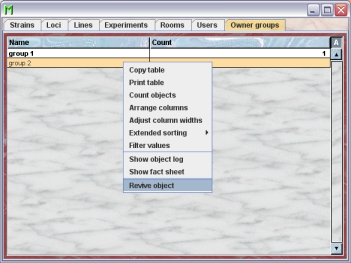Mausoleum
Owner groups
In brief
Mice can be owned by users who are either MASTER, EXTERNAL, STUDENT or GURU. If some members of your lab share mice it can be a bit unconvenient to add all of these users independently as owners of the respective mice. Even worse when one of those people leaves the lab. Then you have to remove this member manually from the owner list of the shared mice. To make these thing easier there are the owner groups which contain an arbitrary number of users who have the privilege to own mice. You can set such a owner group as owner of mice just like a normal user. When Mausoleum tries to figure out whether the logged in user might alter the mouse it first checks whether the user directly owns this mouse and if not it looks whether the user is member of a group listed as owner of this mouse. If members are added to or removed from an owner group this mechanism automatically ensures that the permission changes immediately for all mice owned by the respective owner group.
Only GURUs can add and define owner groups.
The owner group table
By clicking "Owner groups" in the object selection field of the Inspector you will get a window with the table of all actually defined owner groups of the group.

Using the command "Arrange columns" from the context menu (right mouse click in the table) you can specify which attributes of the owner groups should be shown in this table. These attributes are available for the locus table:
| Column header | Description | Sortable | Filterable | Colorable |
| Color | The color of the owner group | ✓ | ||
| Count | The count of contained objects | ✓ | ||
| Foreign key | Foreign ID from other system | ✓ | ||
| Group | Group name | ✓ | ✓ | |
| ID | The technical ID | ✓ | ||
| Name | The name of the owner group | ✓ | ||
| end | The end date of the object | ✓ | ||
| start | The start date of the object | ✓ |
In the owner group table a GURU can specify whether only the active owner groups should be displayed in the table or also the inactivated owner groups. To switch between these display modes you use the little "A" button in top right corner of the table:

If this button is active (pressed) the GURU will see all objects of the group. The active objects are shown in bold whereas inactive objects are shown with in italics.
The Owner group inspector
The owner group inspector is active as soon as the owner group table becomes the active table. It will adopt to the attributes of the selected owner group and lets the user modify the attributes if the user has sufficient privileges to do so. The owner group inspector has four tabs
The "Attributes" tab
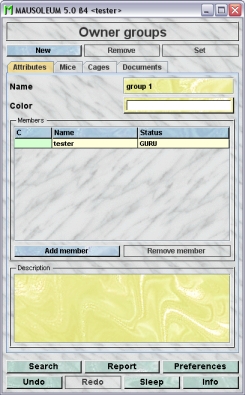
It shows the attributes of the selected owner group:
- Name: The name of the selected owner group. It can be changed by the GURU.
- Color: The GURU can assign a color to a owner group. It is very convenient to assign colours such that owner groups can be discerned or grouped. A description of the Color choose dialog can be fond here.
- Description: In this field the GURU can type in a more thorough description of the selected owner group. Remember that you have to use the "Set"-button to transmit the changes in this field to the database. It is not possible to edit the comments if more than one object is selected.
In the middle section of this tab you find a table which shows the current members of the select owner group. The GURU can add new members by clicking "Add member". In a dialog the possible candidates are presented. The candidates are the actual users of the group who can own mice and are not member of the selected owner group already. The GURU can remove members by selecting a user in the member table and clicking the button "Remove member".
The "Mice" tab
In this tab you see a table with the mice which are owned by one of the selected owner groups.
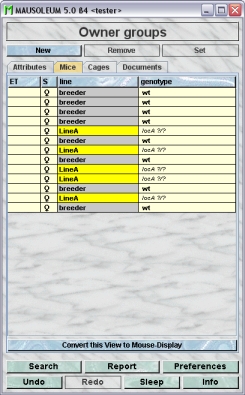
Because this table is within the inspector it cannot be used to modify the attributes of the displayed mice. To generated a mouse table which can be used to alter the attributes of the mice you click the button "Convert this view to Mouse display" and a window with a table containg the mice will open:
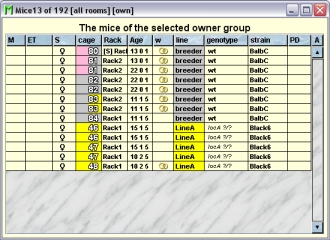
The "Cages" tab
In this tab you see a table with the cages which contain mice which are owned by one of the selected owner groups.
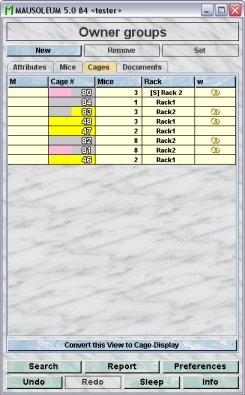
Because this table is within the inspector it cannot be used to modify the attributes of the displayed cages. To generated a cage table which can be used to alter the attributes of the cages you click the button "Convert this view to Cage display" and a window with a table containg the cages will open:
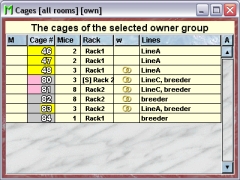
The "Documents" tab
This tab lets you store and exchange documents like pdf- or Word-files with additional informations about the owner groups of your group. In this tab you will find a list with the document which have been uploaded to the server.
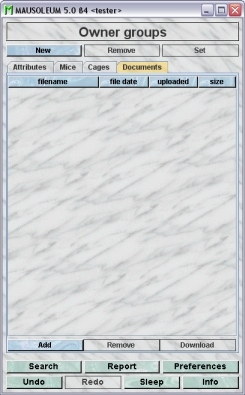
GURUs can add new documents for the selected objects by clicking the "Add"-button beneath the documents list. You will be asked for the location of the document and after congfiming this dialog the file is uploaded top the server and will be displayed in the list. GURUs can also remove documents by selecting one of the documents in the list and clicking the "Remove"-button beneath the documents list. You can download a document and store it on your client computer by clicking the "Download"-button.
Adding Owner groups
A GURU can add new owner groups. To do so select "Owner groups" in the object selection field of the Inspector. After clicking the "New"-button in the inspector you will be asked for the name of the owner group:

After typing the name of the new owner group you confirm the dialog by clicking "YES" and the new owner group will be created in the database.
Removing Owner groups
Only GURUS can remove owner groups. Removing an owner group will not remove it from the database. It merely becomes invisible to the users and cannot be selected as owner for a mouse anymore. But mice having the respective owner group defined as owner keep it even if it was removed.
To remove a particular owner group select it in the owner group table and click the "Remove"-button in the owner group inspector. If you answer the security dialog with "YES" the owner group will become invisible.
Reviving Owner groups
The GURU of Group can revive removed owner groups. To do so first you have to make the owner group visible in the owner group table. You can do it using the "A" button in the upper right corner of the table.

Then you have to select the particular owner group and select "Revive object" in the context menu (invoked by right mouse click)
